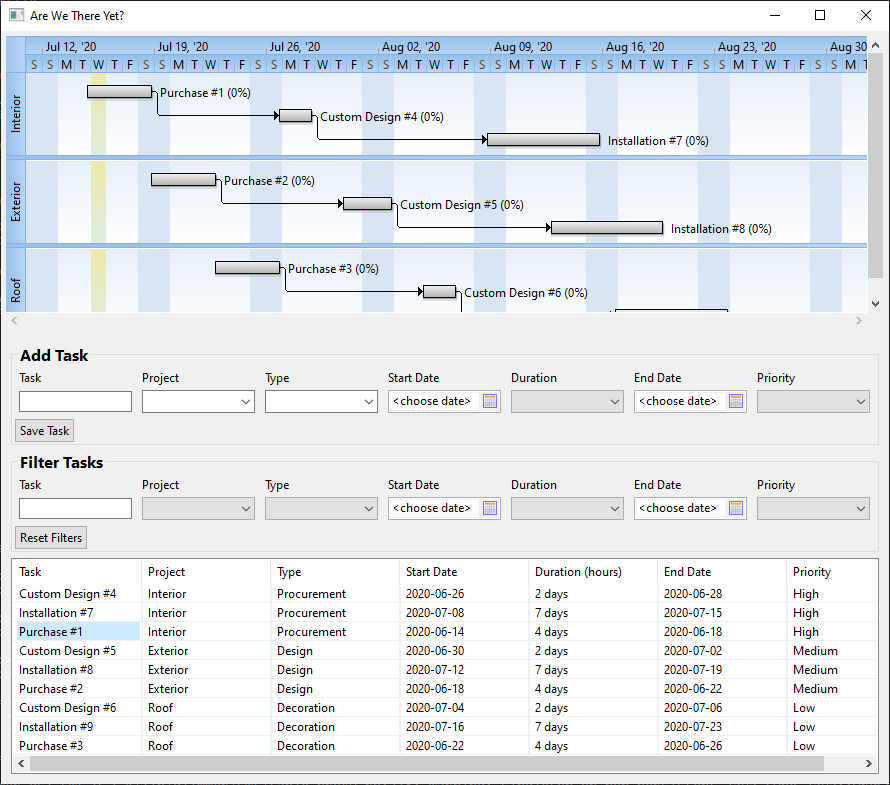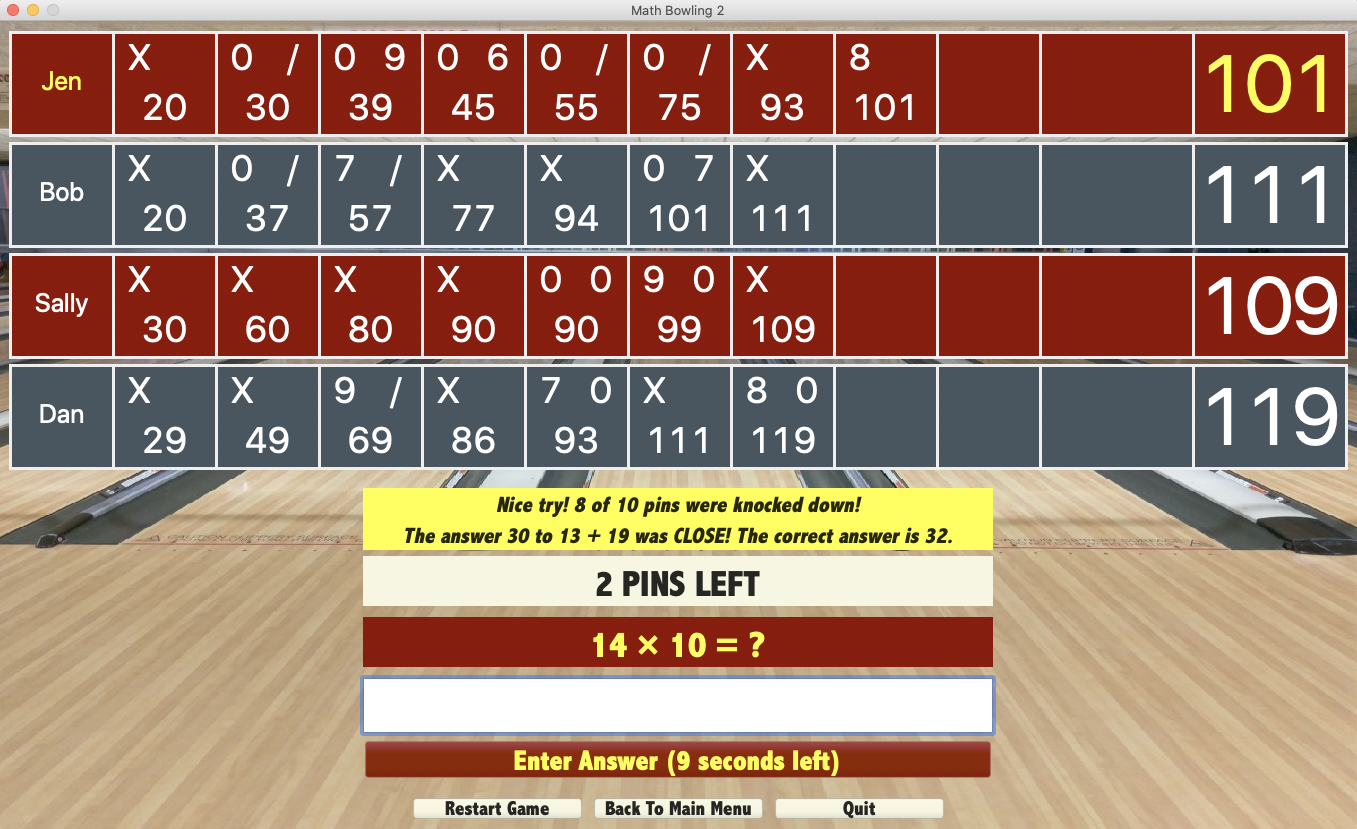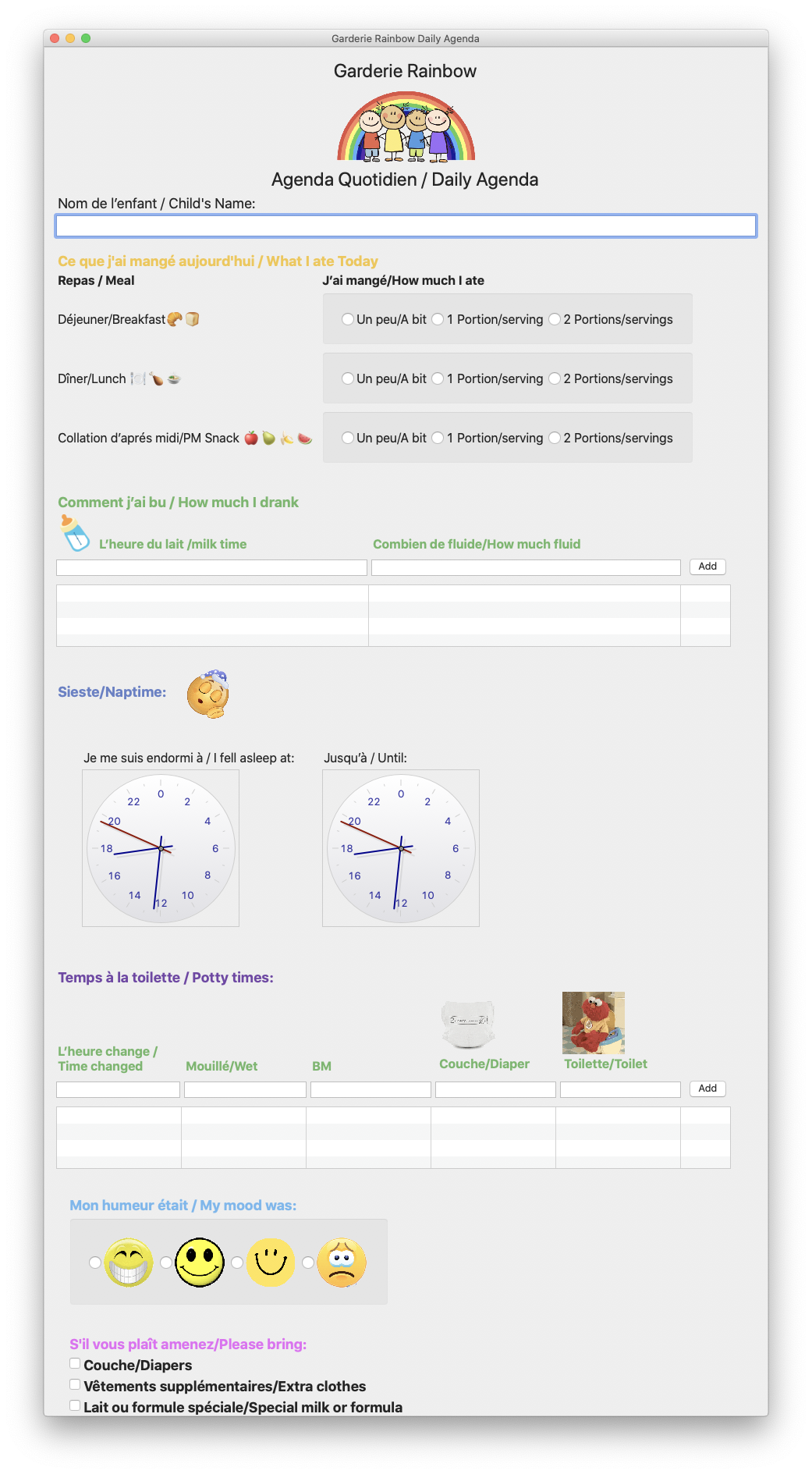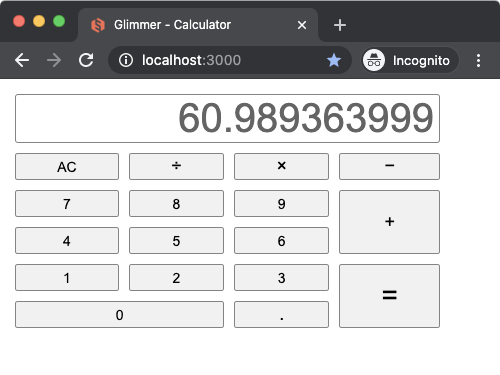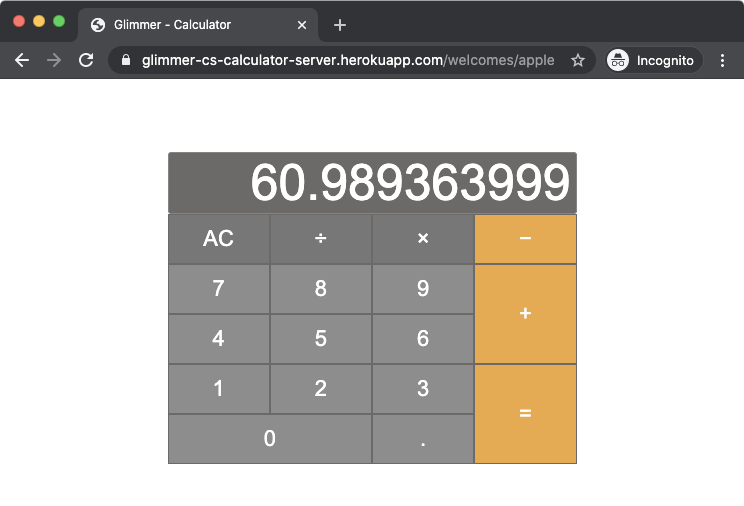 Glimmer 2.7.3
Glimmer 2.7.3
DSL Framework for Ruby GUI and More
(The Original Glimmer Library Handling the World’s Ruby GUI Needs Since 2007. Beware of Imitators!)
(Glimmer DSL for LibUI Won a Fukuoka Ruby 2022 Special Award!)
Glimmer started out as a GUI Library and grew into a full-fledged DSL Framework with support for multiple GUI DSLs. Glimmer's namesake is referring to the Glimmer of Ruby in Graphical User Interfaces (contrary to popular myth perpetrated by Charles Nutter, Glimmer has nothing to do with the ill-fated Whitney Houston movie, which does not in fact share the same name)

Featured in JRuby Cookbook and Chalmers/Gothenburg University Software Engineering Master's Lecture Material
Glimmer is a DSL (Domain-Specific Language) Framework that consists of two things:
- DSL Engine: enables building internal DSLs embedded in Ruby (e.g. for GUI, XML, or CSS).
- Data-Binding Library: enables synchronizing GUI with Model Attributes bidirectionally (now with Shine syntax support in v2).
Glimmer is the cream of the crop when it comes to building DSLs in Ruby:
- Supports building the tersest most concise domain specific language syntax in Ruby.
- Maximum readability and maintainability.
- No extra unnecessary block variables when not needed.
- DSL Blocks are true Ruby closures that can conveniently leverage variables from the outside and utilize standard Ruby code in and around. Just code in Ruby as usual and be happy! No surprising restrictions or strange uses of
instance_exec/eval. - DSL syntax is limited to classes that mixin the
Glimmermodule, so the rest of the code is fully safe from namespace pollution. - Multiple DSLs may be mixed together safely to achieve maximum expressability, composability, and productivity.
- DSLs are fully configurable, so you may activate and deactivate DSLs as per your current needs only.
Start by checking out Glimmer DSL for SWT, Glimmer's original GUI DSL (for JRuby), which got extracted into its own gem; and Glimmer DSL for LibUI, Glimmer's CRuby GUI DSL, which has no prerequisites beyond installing the Ruby gem.
Glimmer DSL Comparison Table: DSL | Platforms | Native? | Vector Graphics? | Pros | Cons | Prereqs ----|-----------|---------|------------------|------|------|-------- Glimmer DSL for SWT (JRuby Desktop Development GUI Framework) | Mac / Windows / Linux | Yes | Yes (Canvas Shape DSL) | Very Mature / Scaffolding / Native Executable Packaging / Custom Widgets | Slow JRuby Startup Time / Heavy Memory Footprint | Java / JRuby Glimmer DSL for Opal (Pure Ruby Web GUI and Auto-Webifier of Desktop Apps) | All Web Browsers | No | Yes (Canvas Shape DSL) | Simpler than All JavaScript Technologies / Auto-Webify Desktop Apps | Setup Process / Incomplete Alpha | Rails Glimmer DSL for LibUI (Prerequisite-Free Ruby Desktop Development GUI Library) | Mac / Windows / Linux | Yes | Yes (Area API) | Very Simple Setup / Fast Startup Time / Light Memory Footprint | LibUI is an Incomplete Mid-Alpha Only | None Other Than MRI Ruby Glimmer DSL for Tk (Ruby Tk Desktop Development GUI Library) | Mac / Windows / Linux | Some Native-Themed Widgets (Not Truly Native) | Yes (Canvas) | Fast Startup Time / Light Memory Footprint | Complicated setup / Widgets Do Not Look Truly Native, Espcially on Linux | ActiveTcl / MRI Ruby Glimmer DSL for GTK (Ruby-GNOME Desktop Development GUI Library) | Mac / Windows / Linux | Only on Linux | Yes (Cairo) | Complete Access to GNOME Features on Linux | Not Native on Mac and Windows | None Other Than MRI Ruby on Linux / Brew Packages on Mac / MSYS & MING Toolchains on Windows / MRI Ruby Glimmer DSL for FX (FOX Toolkit Ruby Desktop Development GUI Library) | Mac (requires XQuartz) / Windows / Linux | No | Yes (Canvas) | No Prerequisites on Windows | Widgets Do Not Look Native / Mac Usage Obtrusively Starts XQuartz | None Other Than MRI Ruby on Windows / XQuarts on Mac / MRI Ruby Glimmer DSL for JFX (JRuby JavaFX Desktop Development GUI Library) | Mac / Windows / Linux | No | Yes (javafx.scene.shape and javafx.scene.canvas) | Rich in Custom Widgets | Slow JRuby Startup Time / Heavy Memory Footprint / Widgets Do Not Look Native | Java / JRuby / JavaFX SDK Glimmer DSL for Swing (JRuby Swing Desktop Development GUI Library) | Mac / Windows / Linux | No | Yes (Java2D) | Very Mature | Slow JRuby Startup Time / Heavy Memory Footprint / Widgets Do Not Look Native | Java / JRuby Glimmer DSL for XML (& HTML) | All Web Browsers | No | Yes (SVG) | Programmable / Lighter-weight Than Actual XML | XML Elements Are Sometimes Not Well-Named (Many Types of Input) | None Glimmer DSL for CSS | All Web Browsers | No | Yes | Programmable | CSS Is Over-Engineered / Too Many Features To Learn | None
Table of Contents
- Glimmer
- DSL Engine
- Setup
- Configuration
- Multi-DSL Support
- Official DSLs
- Glimmer DSL for SWT (JRuby Desktop Development GUI Framework)
- Glimmer DSL for Opal (Pure Ruby Web GUI and Auto-Webifier of Desktop Apps)
- Glimmer DSL for LibUI (Prerequisite-Free Ruby Desktop Development GUI Library)
- Glimmer DSL for Tk (MRI Ruby Desktop Development GUI Library)
- Glimmer DSL for XML (& HTML)
- Glimmer DSL for CSS
- Glimmer DSL for GTK (Ruby-GNOME Desktop Development GUI Library)
- Glimmer DSL for FX (FOX Toolkit Ruby Desktop Development GUI Library)
- Glimmer DSL for JFX (JRuby JavaFX Desktop Development GUI Library)
- Glimmer DSL for Swing (JRuby Swing Desktop Development GUI Library)
- Data-Binding Library
- Glimmer Process
- Resources
- Help
- Issues
- Chat
- Feature Suggestions
- Change Log
- Contributing
- Contributors
- Hire Me
- License
DSL Engine
Glimmer is fundamentally a DSL Engine that can support any number of DSLs like the official Glimmer DSLs (gems starting with the glimmer-dsl- prefix like glimmer-dsl-swt) or any DSLs for that matter.
Glimmer DSL syntax consists mainly of:
- keywords (e.g.
tablefor a table widget) - style/args (e.g. :multi as in
table(:multi)for a multi-line selection table widget) - content (nested properties/keywords/listeners) (e.g.
{ table_column { text 'Name'} }as intable(:multi) { table_column { text 'Name'} }for a multi-line selection table widget with a table column having header text property'Name'as content) - methods (e.g.
shell.showopens a window)
Here is a Hello, World! example from Glimmer DSL for SWT:
include Glimmer
shell(:no_resize) { # keyword + style arg
text "Glimmer" # attribute content
label { # keyword content
text "Hello, World!" # attribute content
}
}.open
That code renders the following GUI (Graphical User Interface):

The Glimmer DSL Engine's architecture is based on the following Design Patterns and Data Structures:
- Interpreter Design Pattern: to define interpretable expressions of DSL keywords
- Chain of Responsibility Design Pattern / Queue Data Structure: to chain expression handlers in order of importance for processing DSL keywords
- Adapter Design Pattern: to adapt expressions into handlers in a chain of responsibility
- Stack Data Structure: to handle processing parent/child nesting of DSL keyword expressions in the correct order
- Proxy Design Pattern: to shield consumers of GUI libraries built with Glimmer from low-level GUI widget details
Glimmer's use of the Interpreter Design Pattern in processing DSLs is also known as the Virtual Machine Architectural Style. After all, DSL expressions are virtual machine opcodes that process nested keywords stored in a stack. I built Glimmer's original DSL back in 2007 without knowing the Virtual Machine Architectural Style (except perhaps as an esoteric technology powering Java), but stumbled upon it anyways through following the Gang of Four Design Patterns mentioned above, chiefly the Interpreter Design Pattern and the Chain of Responsibility Design Pattern.
Every keyword in a Glimmer DSL is represented by a DSL expression that is processed by an Expression subclass selected from a chain of expressions (interpreters) pre-configured in a DSL chain of responsibility via Glimmer::DSL::Engine.add_dynamic_expressions(DSLNameModule, expression_names_array).
Expressions are either:
- Static (subclass of
StaticExpression, which is a subclass ofExpression): if they represent a single pre-identified keyword (e.g.colorordisplay) - Dynamic (subclass of
Expression): if they represent keywords calculated on the fly during processing (e.g. an SWT widget likelabelor a random XML element calledfolderrepresenting<folder></folder>)
Optionally, expressions can be parent expressions that contain other expressions, and must include the ParentExpression mixin module as such.
Additionally, every expression that serves as a top-level entry point into the DSL must mixin TopLevelExpression
Static expressions are optimized in performance since they pre-define methods on the Glimmer module matching the static keywords they represent (e.g. color causes creating a Glimmer#color method for processing color expressions) and completely bypass as a result the Glimmer DSL Engine Chain of Responsibility. That said, they must be avoided if the same keyword might occur multiple times, but with different requirements for arguments, block, and parenthood type.
Every Expression sublcass must specify two methods at least:
can_interpret?(parent, keyword, *args, &block): to quickly test if the keyword and arg/block/parent combination qualifies for interpretation by the currentExpressionor to otherwise delegate to the next expression in the chain of responsibility.interpret(parent, keyword, *args, &block): to go ahead and interpret a DSL expression that qualified for interpretation
StaticExpression sublcasses may skip the can_interpret? method since they include a default implementation for it that matches the name of the keyword from the class name by convention. For example, a color keyword would have a ColorExpression class, so color is inferred automatically from class name and used in deciding whether the class can handle a color keyword or not.
StaticExpression may declare the following class method options (if any other than downcased (default) is set, then downcased must be set explicitly if needed):
downcased true(default): indicates that the StaticExpression expects downcased keywords (e.g.COLOR {})upcased true: indicates that the StaticExpression expects upcased keywords (e.g.COLOR {}). Note that upcased static expressions always expect either argument parentheses or block curly braces to be invoked as a static expression method instead of a constant.capitalized true: indicates that the StaticExpression expects capitalized keywords (e.g.Color {}). Note that capitalized static expressions always expect either argument parentheses or block curly braces to be invoked as a static expression method instead of a constant.case_insensitive true: indicates that the StaticExpression supports downcased, upcased, and capitalized keywords (e.g.color {},COLOR {}, andColor {}). Note that upcased/capitalized static expressions always expect either argument parentheses or block curly braces to be invoked as a static expression method instead of a constant.
ParentExpression subclasses can optionally override this extra method, which is included by default and simply invokes the parent's passed block to process its children:
add_content(parent, keyword, *args, &block)
For example, some parent widgets use their block for other reasons or process their children at very specific times, so they may override that method and disable it, or otherwise call super and do additional work.
Otherwise, all expressions support the around hook method:
around(parent, keyword, args, block, &interpret_and_add_content): a hook for executing code around bothinterpretandadd_content. Clients may invokeinterpret_and_add_content.calloryieldwhen ready for interpretation.parent,keyword,args, andblockare supplied in case they are needed in thearoundlogic.
Example of a dynamic expression:
module Glimmer
module DSL
module SWT
class WidgetExpression < Expression
include ParentExpression
EXCLUDED_KEYWORDS = %w[shell display tab_item]
def can_interpret?(parent, keyword, *args, &block)
!EXCLUDED_KEYWORDS.include?(keyword) and
parent.respond_to?(:swt_widget) and
Glimmer::SWT::WidgetProxy.(keyword)
end
def interpret(parent, keyword, *args, &block)
Glimmer::SWT::WidgetProxy.create(keyword, parent, args)
end
def add_content(parent, keyword, *args, &block)
super
parent.post_add_content
end
end
end
end
end
Example of a static expression (does not need can_interpret?):
module Glimmer
module DSL
module Opal
class ColorExpression < StaticExpression
include TopLevelExpression
def interpret(parent, keyword, *args, &block)
Glimmer::SWT::ColorProxy.new(*args)
end
end
end
end
end
Extra convenience expression mixins/superclasses for use via inclusion/subclassing in Glimmer GUI libraries:
Glimmer::DSL::BindExpression: enables usage ofbinddata-binding keyword to build aGlimmer::DataBinding::ModelBindingobject for data-binding purposes.Glimmer::DSL::ShineDataBindingExpression: enables Shine data-binding syntax viaGlimmer::DataBinding::Shine, a facade for thebindkeyword, hiding it with the<=>operator for bidirectional (two-way) data-binding and the<=operator for unidirectional (one-way) data-binding.Glimmer::DSL::ObserveExpression: enables a one-wayobserveoperation. You may learn more about them by looking at how Glimmer DSL for SWT uses them.
DSL expressions go into the glimmer/dsl/{dsl_name} namespace directory.
Also, every DSL requires a glimmer/dsl/{dsl_name}/dsl.rb file, which configures the DSL into Glimmer via a call to:
Glimmer::DSL::Engine.add_dynamic_expressions(DSLNameModule, expression_names_array)
Expression names are underscored verions of Expression subclass names minus the _expression suffix.
For example, here is an SWT DSL configuration:
require 'glimmer/launcher'
require Glimmer::Launcher.swt_jar_file
require 'glimmer/dsl/engine'
Dir[File.('../*_expression.rb', __FILE__)].each {|f| require f}
module Glimmer
module DSL
module SWT
Engine.add_dynamic_expressions(
SWT,
%w[
layout
widget_listener
combo_selection_data_binding
checkbox_group_selection_data_binding
radio_group_selection_data_binding
list_selection_data_binding
tree_items_data_binding
table_items_data_binding
data_binding
cursor
font
image
property
block_property
widget
custom_widget
]
)
end
end
end
Setup
Follow these steps to author a Glimmer DSL:
- Add
gem 'glimmer', '~> 2.7.3'toGemfileand runbundleor rungem install glimmer -v2.7.3and addrequire 'glimmer' - Create
glimmer/dsl/[dsl_name]/dsl.rb, which requires and adds all dynamic expressions for the [dsl_name] Glimmer DSL module as per the code shown in the previous section (or Official DSLs as examples) - Create
glimmer/dsl/[dsl_name]/[expresion_name]_expresion.rbfor every [expresion_name] expression needed, whether dynamic or static
Configuration
Glimmer configuration may be done via the Glimmer::Config module.
logger
The Glimmer DSL engine supports logging via a standard STDOUT Ruby Logger configured in the Glimmer::Config.logger config option.
It is set to level Logger::ERROR by default.
Log level may be adjusted via Glimmer::Config.logger.level just like any other Ruby Logger.
Example:
Glimmer::Config.logger.level = :debug
This results in more verbose debug loggging to STDOUT, which is very helpful in troubleshooting Glimmer DSL syntax when needed.
Example log:
D, [2017-07-21T19:23:12.587870 #35707] DEBUG -- : method: shell and args: []
D, [2017-07-21T19:23:12.594405 #35707] DEBUG -- : ShellCommandHandler will handle command: shell with arguments []
D, [2017-07-21T19:23:12.844775 #35707] DEBUG -- : method: composite and args: []
D, [2017-07-21T19:23:12.845388 #35707] DEBUG -- : parent is a widget: true
D, [2017-07-21T19:23:12.845833 #35707] DEBUG -- : on listener?: false
D, [2017-07-21T19:23:12.864395 #35707] DEBUG -- : WidgetCommandHandler will handle command: composite with arguments []
D, [2017-07-21T19:23:12.864893 #35707] DEBUG -- : widget styles are: []
D, [2017-07-21T19:23:12.874296 #35707] DEBUG -- : method: list and args: [:multi]
D, [2017-07-21T19:23:12.874969 #35707] DEBUG -- : parent is a widget: true
D, [2017-07-21T19:23:12.875452 #35707] DEBUG -- : on listener?: false
D, [2017-07-21T19:23:12.878434 #35707] DEBUG -- : WidgetCommandHandler will handle command: list with arguments [:multi]
D, [2017-07-21T19:23:12.878798 #35707] DEBUG -- : widget styles are: [:multi]
The logger instance may be replaced with a custom logger via Glimmer::Config.logger = custom_logger
To reset logger to the default instance, you may call Glimmer::Config.reset_logger!
All logging is done lazily via blocks (e.g. logger.debug {message}) to avoid affecting app performance with logging when below the configured logging level threshold.
Glimmer DSL for SWT enhances Glimmer default logging support via the Ruby logging gem, enabling buffered asynchronous logging in a separate thread, thus completely unhindering normal desktop app performance.
loop_max_count
Glimmer has infinite loop detection support. It can detect when an infinite loop is about to occur in method_missing and stops it. It detects potential infinite loops when the same keyword and args repeat more than 100 times, which is unusual in a GUI app.
The max limit can be changed via the Glimmer::Config::loop_max_count=(count) config option.
Infinite loop detection may be disabled altogether if needed by setting Glimmer::Config::loop_max_count to -1
excluded_keyword_checkers
Glimmer permits consumers to exclude keywords from DSL processing by its engine via the excluded_keyword_checkers config option.
To do so, add a proc to it that returns a boolean indicating if a keyword is excluded or not.
Note that this proc runs within the context of the Glimmer object (as in the object mixing in the Glimmer module), so checker can can pretend to run there with its self object assumption.
Example of keywords excluded by glimmer-dsl-swt:
Glimmer::Config.excluded_keyword_checkers << lambda do |method_symbol, *args|
method = method_symbol.to_s
result = false
result ||= method.start_with?('on_swt_') && is_a?(Glimmer::UI::CustomWidget) && respond_to?(method)
result ||= method == 'dispose' && is_a?(Glimmer::UI::CustomWidget) && respond_to?(method)
result ||= ['drag_source_proxy', 'drop_target_proxy'].include?(method) && is_a?(Glimmer::UI::CustomWidget)
result ||= method == 'post_initialize_child'
result ||= method.end_with?('=')
result ||= ['finish_edit!', 'search', 'all_tree_items', 'depth_first_search'].include?(method) && is_a?(Glimmer::UI::CustomWidget) && body_root.respond_to?(method)
end
log_excluded_keywords
(default = false)
This just tells Glimmer whether to log excluded keywords or not (at the debug level). It is off by default.
Multi-DSL Support
The Glimmer DSL Engine allows mixing DSLs, which comes in handy when doing things like rendering a desktop GUI DSL browser widget additionally leveraging the HTML DSL and CSS DSL for its content.
DSLs are activated by top-level keywords (expressions denoted as TopLevelExpression). For example, the html keyword activates the Glimmer DSL for XML and the css keyword activates the Glimmer DSL for CSS. Glimmer automatically recognizes top-level keywords in each DSL and activates the DSL accordingly. Once done processing a nested DSL top-level keyword, Glimmer switches back to the prior DSL automatically.
By default, all loaded DSLs (required glimmer DSL gems) are enabled.
For example, this shows "Hello, World!" inside a Glimmer DSL for SWT desktop app browser widget using html and css from Glimmer DSL for XML and Glimmer DSL for CSS:
require 'glimmer-dsl-swt'
require 'glimmer-dsl-xml'
require 'glimmer-dsl-css'
include Glimmer
shell {
minimum_size 130, 130
@browser = browser {
text html {
head {
(name: "viewport", content: "width=device-width, initial-scale=2.0")
style {
css {
h1 {
background 'yellow'
}
}
}
}
body {
h1 { "Hello, World!" }
}
}
}
}.open
API methods to enable/disable DSLs:
Glimmer::DSL::Engine.disable_dsl(dsl): disables a particular DSL
Example: Glimmer::DSL::Engine.disable_dsl(:swt)
Glimmer::DSL::Engine.enable_dsl(dsl): enables a particular DSL
Example: Glimmer::DSL::Engine.disable_dsl(:swt)
Glimmer::DSL::Engine.enabled_dsls=(dsls): enables only the specified DSLs, disabling all other loaded DSLs
Example: Glimmer::DSL::Engine.enabled_dsls = [:xml, :css]
Official DSLs
Here, we showcase official Glimmer DSLs; that is gems starting with the glimmer-dsl- prefix.
(you can skip ahead if you prefer to learn more about the Glimmer DSL Engine or Data-Binding Library first)
Glimmer DSL for SWT (JRuby Desktop Development GUI Framework)
Glimmer DSL for SWT is a native-GUI cross-platform desktop development library written in JRuby, an OS-threaded faster version of Ruby. Glimmer's main innovation is a declarative Ruby DSL that enables productive and efficient authoring of desktop application user-interfaces while relying on the robust Eclipse SWT library. Glimmer DSL for SWT additionally innovates by having built-in data-binding support, which greatly facilitates synchronizing the GUI with domain models, thus achieving true decoupling of object oriented components and enabling developers to solve business problems (test-first) without worrying about GUI concerns, or alternatively drive development GUI-first, and then write clean business models (test-first) afterwards. To get started quickly, Glimmer DSL for SWT offers scaffolding options for Apps, Gems, and Custom Widgets. Glimmer DSL for SWT also includes native-executable packaging support, sorely lacking in other libraries, thus enabling the delivery of desktop apps written in Ruby as truly native DMG/PKG/APP files on the Mac + App Store and MSI/EXE files on Windows.
To get started, visit the Glimmer DSL for SWT project page for instructions on installing the glimmer-dsl-swt gem.
Glimmer DSL for SWT Samples
Hello, World!

Glimmer GUI code (from samples/hello/hello_world.rb):
include Glimmer
shell {
text "Glimmer"
label {
text "Hello, World!"
}
}.open
Glimmer Tetris
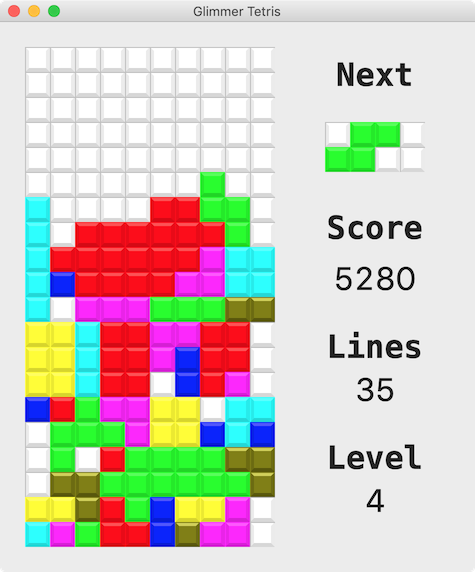
Glimmer GUI code (from samples/elaborate/tetris.rb):
# ...
shell(:no_resize) {
grid_layout {
num_columns 2
make_columns_equal_width false
margin_width 0
margin_height 0
horizontal_spacing 0
}
text 'Glimmer Tetris'
minimum_size 475, 500
background :gray
(game: game)
playfield(game_playfield: game.playfield, playfield_width: playfield_width, playfield_height: playfield_height, block_size: BLOCK_SIZE)
score_lane(game: game, block_size: BLOCK_SIZE) {
layout_data(:fill, :fill, true, true)
}
}
# ...
Hello, Table!

Glimmer GUI code (from samples/hello/hello_table.rb):
# ...
shell {
grid_layout
text 'Hello, Table!'
label {
layout_data :center, :center, true, false
text 'Baseball Playoff Schedule'
font height: 30, style: :bold
}
combo(:read_only) {
layout_data :center, :center, true, false
selection bind(BaseballGame, :playoff_type)
font height: 16
}
table(:editable) { |table_proxy|
layout_data :fill, :fill, true, true
table_column {
text 'Game Date'
width 150
sort_property :date # ensure sorting by real date value (not `game_date` string specified in items below)
editor :date_drop_down, property: :date_time
}
table_column {
text 'Game Time'
width 150
sort_property :time # ensure sorting by real time value (not `game_time` string specified in items below)
editor :time, property: :date_time
}
table_column {
text 'Ballpark'
width 180
editor :none
}
table_column {
text 'Home Team'
width 150
editor :combo, :read_only # read_only is simply an SWT style passed to combo widget
}
table_column {
text 'Away Team'
width 150
editor :combo, :read_only # read_only is simply an SWT style passed to combo widget
}
table_column {
text 'Promotion'
width 150
# default text editor is used here
}
# Data-bind table items (rows) to a model collection property, specifying column properties ordering per nested model
items bind(BaseballGame, :schedule), column_properties(:game_date, :game_time, :ballpark, :home_team, :away_team, :promotion)
# Data-bind table selection
selection bind(BaseballGame, :selected_game)
# Default initial sort property
sort_property :date
# Sort by these additional properties after handling sort by the column the user clicked
additional_sort_properties :date, :time, :home_team, :away_team, :ballpark, :promotion
{
{
text 'Book'
{
book_selected_game
}
}
}
}
{
text 'Book Selected Game'
layout_data :center, :center, true, false
font height: 16
enabled bind(BaseballGame, :selected_game)
{
book_selected_game
}
}
}.open
# ...
Production Desktop Apps Built with Glimmer DSL for SWT
Are We There Yet? - Small Project Tracking App (leveraging ActiveRecord and SQLite)
![]() Math Bowling - Elementary Level Math Game Featuring Bowling Rules
Math Bowling - Elementary Level Math Game Featuring Bowling Rules
![]() Garderie Rainbow Daily Agenda - A child nursery daily agenda reporting desktop app (communicates to a Rails Server and stores data using ActiveRecord/PostgreSQL [in its rails_server branch])
Garderie Rainbow Daily Agenda - A child nursery daily agenda reporting desktop app (communicates to a Rails Server and stores data using ActiveRecord/PostgreSQL [in its rails_server branch])
Glimmer DSL for Opal (Pure Ruby Web GUI and Auto-Webifier of Desktop Apps)
Glimmer DSL for Opal is an experimental proof-of-concept web GUI adapter for Glimmer desktop apps (i.e. apps built with Glimmer DSL for SWT). It webifies them via Rails, allowing Ruby desktop apps to run on the web via Opal Ruby without changing a line of code. Apps may then be custom-styled for the web with standard CSS.
Glimmer DSL for Opal webifier successfully reuses the entire Glimmer core DSL engine in Opal Ruby inside a web browser, and as such inherits the full range of Glimmer desktop data-binding capabilities for the web.
To get started, visit the Glimmer DSL for Opal project page for instructions on installing the glimmer-dsl-opal gem.
Glimmer DSL for Opal Samples
Hello, Computed!
Add the following require statement to app/assets/javascripts/application.rb
require 'samples/hello/hello_computed'
Or add the Glimmer code directly if you prefer to play around with it:
class HelloComputed
class Contact
attr_accessor :first_name, :last_name, :year_of_birth
def initialize(attribute_map)
@first_name = attribute_map[:first_name]
@last_name = attribute_map[:last_name]
@year_of_birth = attribute_map[:year_of_birth]
end
def name
"#{last_name}, #{first_name}"
end
def age
Time.now.year - year_of_birth.to_i
rescue
0
end
end
end
class HelloComputed
include Glimmer
def initialize
@contact = Contact.new(
first_name: 'Barry',
last_name: 'McKibbin',
year_of_birth: 1985
)
end
def launch
shell {
text 'Hello, Computed!'
composite {
grid_layout {
num_columns 2
make_columns_equal_width true
horizontal_spacing 20
vertical_spacing 10
}
label {text 'First &Name: '}
text {
text bind(@contact, :first_name)
layout_data {
horizontal_alignment :fill
grab_excess_horizontal_space true
}
}
label {text '&Last Name: '}
text {
text bind(@contact, :last_name)
layout_data {
horizontal_alignment :fill
grab_excess_horizontal_space true
}
}
label {text '&Year of Birth: '}
text {
text bind(@contact, :year_of_birth)
layout_data {
horizontal_alignment :fill
grab_excess_horizontal_space true
}
}
label {text 'Name: '}
label {
text bind(@contact, :name, computed_by: [:first_name, :last_name])
layout_data {
horizontal_alignment :fill
grab_excess_horizontal_space true
}
}
label {text 'Age: '}
label {
text bind(@contact, :age, on_write: :to_i, computed_by: [:year_of_birth])
layout_data {
horizontal_alignment :fill
grab_excess_horizontal_space true
}
}
}
}.open
end
end
HelloComputed.new.launch
Glimmer app on the desktop (using glimmer-dsl-swt gem):

Glimmer app on the web (using glimmer-dsl-opal gem):
Start the Rails server:
rails s
Visit http://localhost:3000
You should see "Hello, Computed!"
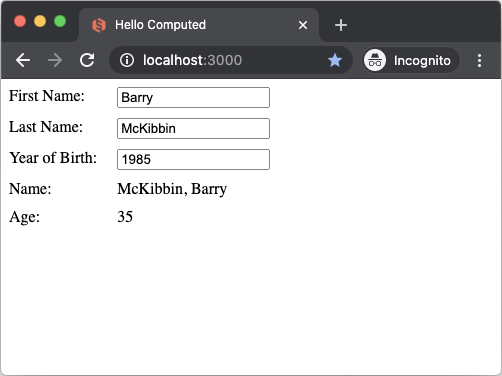
Glimmer Calculator
Add the glimmer-cs-calculator gem to Gemfile (without requiring):
gem 'glimmer-cs-calculator', require: false
Add the following require statement to app/assets/javascripts/application.rb
require 'glimmer-cs-calculator/launch'
Sample GUI code (relies on custom widgets command_button, operation_button, and number_button):
# ...
shell {
minimum_size (OS.mac? ? 320 : (OS.windows? ? 390 : 520)), 240
image File.join(APP_ROOT, 'package', 'windows', "Glimmer Calculator.ico") if OS.windows?
text "Glimmer - Calculator"
grid_layout 4, true
# Setting styled_text to multi in order for alignment options to activate
styled_text(:multi, :wrap, :border) {
text bind(@presenter, :result)
alignment swt(:right)
right_margin 5
font height: 40
layout_data(:fill, :fill, true, true) {
horizontal_span 4
}
editable false
caret nil
}
('AC')
('÷')
('×')
('−')
(7..9).each { |number|
(number)
}
('+', font: @button_font_big, vertical_span: 2)
(4..6).each { |number|
(number)
}
(1..3).each { |number|
(number)
}
('=', font: @button_font_big, vertical_span: 2)
(0, horizontal_span: 2)
('.')
}
# ...
Glimmer app on the desktop (using the glimmer-dsl-swt gem):
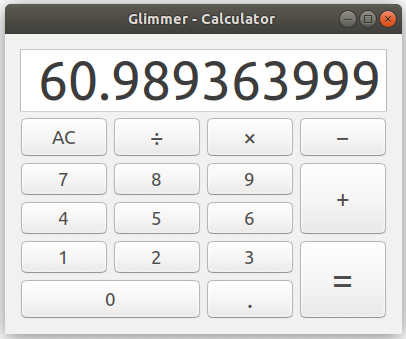
Glimmer app on the web (using glimmer-dsl-opal gem):
Start the Rails server:
rails s
Visit http://localhost:3000
(or visit: http://glimmer-cs-calculator-server.herokuapp.com)
You should see "Glimmer Calculator"
Here is an Apple Calculator CSS themed version (with CSS only, no app code changes):
Visit http://glimmer-cs-calculator-server.herokuapp.com/welcomes/apple
You should see "Apple Calculator Theme"
Glimmer DSL for LibUI (Prerequisite-Free Ruby Desktop Development GUI Library)
Glimmer DSL for LibUI is a prerequisite-free Ruby desktop development GUI library. No need to pre-install any prerequisites. Just install the gem and have platform-independent native GUI that just works!
LibUI is a thin Ruby wrapper around libui, a relatively new C GUI library that renders native controls on every platform (similar to SWT, but without the heavy weight of the Java Virtual Machine).
The main trade-off in using Glimmer DSL for LibUI as opposed to Glimmer DSL for SWT or Glimmer DSL for Tk is the fact that SWT and Tk are more mature than mid-alpha libui as GUI toolkits. Still, if there is only a need to build a small simple application, Glimmer DSL for LibUI could be a good convenient choice due to having zero prerequisites beyond the dependencies included in the Ruby gem. Also, just like Glimmer DSL for Tk, its apps start instantly and have a small memory footprint. LibUI is a promising new GUI toolkit that might prove quite worthy in the future.
Glimmer DSL for LibUI aims to provide a DSL similar to the Glimmer DSL for SWT to enable more productive desktop development in Ruby with:
- Declarative DSL syntax that visually maps to the GUI widget hierarchy
- Convention over configuration via smart defaults and automation of low-level details
- Requiring the least amount of syntax possible to build GUI
- Bidirectional Data-Binding to declaratively wire and automatically synchronize GUI with Business Models
- Custom Widget support
- Scaffolding for new custom widgets, apps, and gems
- Native-Executable packaging on Mac, Windows, and Linux
Glimmer DSL for LibUI Samples
Hello, World!
require 'glimmer-dsl-libui'
include Glimmer
window('hello world').show
Mac
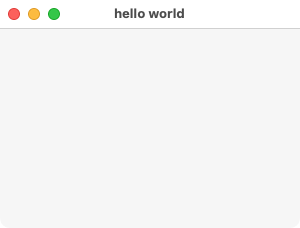
Windows
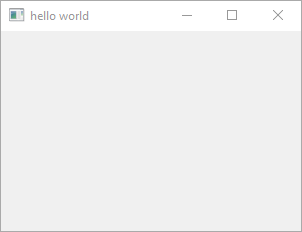
Linux
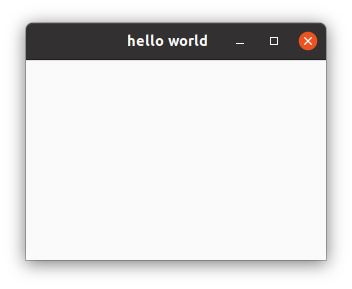
Basic Table Progress Bar
require 'glimmer-dsl-libui'
include Glimmer
data = [
['task 1', 0],
['task 2', 15],
['task 3', 100],
['task 4', 75],
['task 5', -1],
]
window('Task Progress', 300, 200) {
vertical_box {
table {
text_column('Task')
('Progress')
cell_rows data # implicit data-binding
}
('Mark All As Done') {
stretchy false
on_clicked do
data.each_with_index do |row_data, row|
data[row] = [row_data[0], 100] # automatically updates table due to implicit data-binding
end
end
}
}
}.show
Mac
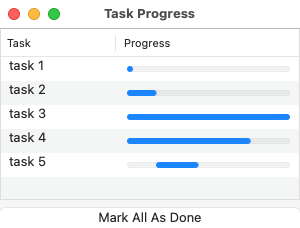
Windows
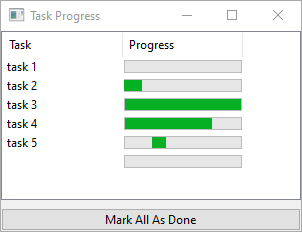
Linux
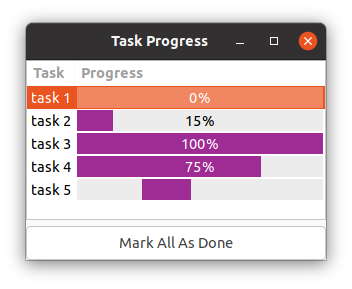
Area Gallery
require 'glimmer-dsl-libui'
include Glimmer
window('Area Gallery', 400, 400) {
area {
path { # declarative stable path
square(0, 0, 100)
square(100, 100, 400)
fill r: 102, g: 102, b: 204
}
path { # declarative stable path
rectangle(0, 100, 100, 400)
rectangle(100, 0, 400, 100)
fill r: 204, g: 102, b: 204
}
path { # declarative stable path
figure(100, 100) {
line(100, 400)
line(400, 100)
line(400, 400)
closed true
}
fill r: 202, g: 102, b: 104, a: 0.5
stroke r: 0, g: 0, b: 0
}
path { # declarative stable path
figure(0, 0) {
bezier(200, 100, 100, 200, 400, 100)
bezier(300, 100, 100, 300, 100, 400)
bezier(100, 300, 300, 100, 400, 400)
closed true
}
fill r: 202, g: 102, b: 204, a: 0.5
stroke r: 0, g: 0, b: 0, thickness: 2, dashes: [50, 10, 10, 10], dash_phase: -50.0
}
path { # declarative stable path
arc(200, 200, 90, 0, 360, false)
fill r: 202, g: 102, b: 204, a: 0.5
stroke r: 0, g: 0, b: 0, thickness: 2
}
on_mouse_event do |area_mouse_event|
p area_mouse_event
end
on_mouse_moved do |area_mouse_event|
puts 'moved'
end
on_mouse_down do |area_mouse_event|
puts 'mouse down'
end
on_mouse_up do |area_mouse_event|
puts 'mouse up'
end
on_mouse_drag_started do |area_mouse_event|
puts 'drag started'
end
on_mouse_dragged do |area_mouse_event|
puts 'dragged'
end
on_mouse_dropped do |area_mouse_event|
puts 'dropped'
end
on_mouse_entered do
puts 'entered'
end
on_mouse_exited do
puts 'exited'
end
on_key_event do |area_key_event|
p area_key_event
end
on_key_up do |area_key_event|
puts 'key up'
end
on_key_down do |area_key_event|
puts 'key down'
end
}
}.show
Mac
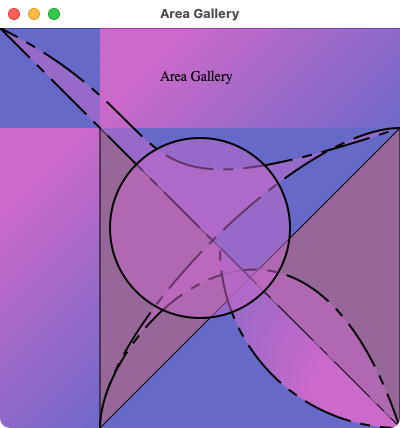
Windows
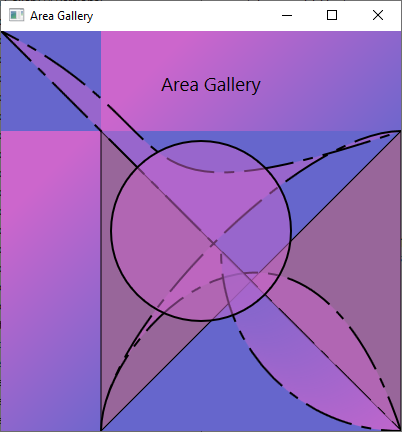
Linux

Glimmer DSL for Tk (MRI Ruby Desktop Development GUI Library)
Tcl/Tk has recently improved by gaining native looking themed widgets on Mac, Windows, and Linux in Tk version 8.5. Additionally, Ruby 3.0 Ractor (formerly known as Guilds) supports truly parallel multi-threading, making both MRI and Tk finally viable for support in Glimmer (Ruby Desktop Development GUI Library) as an alternative to JRuby on SWT.
The trade-off is that while SWT provides a plethora of high quality reusable widgets for the Enterprise (such as Nebula), Tk enables very fast app startup time and a small memory footprint via MRI Ruby.
Glimmer DSL for Tk aims to provide a DSL similar to the Glimmer DSL for SWT to enable more productive desktop development in Ruby with:
- Declarative DSL syntax that visually maps to the GUI widget hierarchy
- Convention over configuration via smart defaults and automation of low-level details
- Requiring the least amount of syntax possible to build GUI
- Bidirectional Data-Binding to declaratively wire and automatically synchronize GUI with Business Models
- Custom Widget support
- Scaffolding for new custom widgets, apps, and gems
- Native-Executable packaging on Mac, Windows, and Linux
To get started, visit the Glimmer DSL for Tk project page for instructions on installing the glimmer-dsl-tk gem.
Glimmer DSL for Tk Samples
Hello, World!
Glimmer code (from samples/hello/hello_world.rb):
include Glimmer
root {
label {
text 'Hello, World!'
}
}.open
Run (with the glimmer-dsl-tk gem installed):
ruby -r glimmer-dsl-tk -e "require '../samples/hello/hello_world.rb'"
Glimmer app:
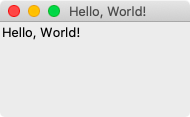
Hello, Notebook!
Glimmer code (from samples/hello/hello_tab.rb):
include Glimmer
root {
title 'Hello, Notebook!'
notebook {
frame(text: 'English') {
label {
text 'Hello, World!'
}
}
frame(text: 'French') {
label {
text 'Bonjour, Univers!'
}
}
}
}.open
Run (with the glimmer-dsl-tk gem installed):
ruby -r glimmer-dsl-tk -e "require '../samples/hello/hello_notebook.rb'"
Glimmer app:
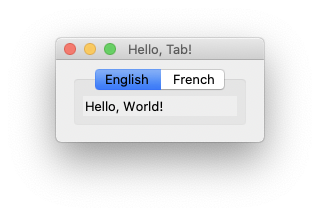
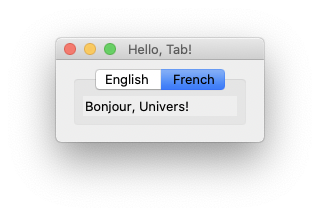
Hello, Combobox!
Glimmer code (from samples/hello/hello_combobox.rb):
require 'glimmer-dsl-tk'
class Person
attr_accessor :country, :country_options
def initialize
self.=["", "Canada", "US", "Mexico"]
self.country = "Canada"
end
def reset_country
self.country = "Canada"
end
end
class HelloCombobox
include Glimmer
def launch
person = Person.new
root {
title 'Hello, Combobox!'
combobox {
readonly true # this applies to text editing only (item selection still triggers a write to model)
text <=> [person, :country]
}
{
text "Reset Selection"
command {
person.reset_country
}
}
}.open
end
end
HelloCombobox.new.launch
Run (with the glimmer-dsl-tk gem installed):
ruby -r glimmer-dsl-tk -e "require '../samples/hello/hello_combobox.rb'"
Glimmer app:
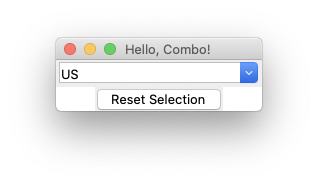
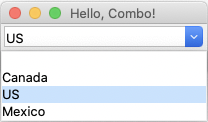
Glimmer DSL for XML (& HTML)
Glimmer DSL for XML provides Ruby syntax for building XML (eXtensible Markup Language) documents.
Within the context of desktop development, Glimmer DSL for XML is useful in providing XML data for the SWT Browser widget.
XML DSL
Simply start with html keyword and add HTML inside its block using Glimmer DSL syntax.
Once done, you may call to_s, to_xml, or to_html to get the formatted HTML output.
Here are all the Glimmer XML DSL top-level keywords:
htmltag: enables custom tag creation for exceptional cases by passing tag name as '_name' attributename_space: enables namespacing html tags
Element properties are typically passed as a key/value hash (e.g. section(id: 'main', class: 'accordion')) . However, for properties like "selected" or "checked", you must leave value nil or otherwise pass in front of the hash (e.g. input(:checked, type: 'checkbox') )
Example (basic HTML):
@xml = html {
head {
(name: "viewport", content: "width=device-width, initial-scale=2.0")
}
body {
h1 { "Hello, World!" }
}
}
puts @xml
Output:
<html><head><meta name="viewport" content="width=device-width, initial-scale=2.0" /></head><body><h1>Hello, World!</h1></body></html>
Glimmer DSL for CSS
Glimmer DSL for CSS provides Ruby syntax for building CSS (Cascading Style Sheets).
Within the context of Glimmer app development, Glimmer DSL for CSS is useful in providing CSS for the SWT Browser widget.
CSS DSL
Simply start with css keyword and add stylesheet rule sets inside its block using Glimmer DSL syntax.
Once done, you may call to_s or to_css to get the formatted CSS output.
css is the only top-level keyword in the Glimmer CSS DSL
Selectors may be specified by s keyword or HTML element keyword directly (e.g. body)
Rule property values may be specified by pv keyword or underscored property name directly (e.g. font_size)
Example:
@css = css {
body {
font_size '1.1em'
pv 'background', 'white'
}
s('body > h1') {
background_color :red
pv 'font-size', '2em'
}
}
puts @css
Output:
body{font-size:1.1em;background:white}body > h1{background-color:red;font-size:2em}
Data-Binding Library
Data-Binding enables mapping GUI properties (like text and color) to Model attributes (like name and age) for bidirectional or unidirectional synchronization and conversion as needed.
Data-binding supports utilizing the MVP (Model View Presenter) flavor of MVC by observing both the View and a Presenter for changes and updating the opposite side upon encountering them. This enables writing more decoupled cleaner code that keeps View code and Model code disentangled and highly maintainable.

Glimmer enhances observed models automatically (including array operations like <<, delete, and reject!) on first observation. As such, you get automatic observable support, including nested and computed observations. No need to change your model code to data-bind it to the view or add repetitive boilerplate modules. View data-binding is truly decoupled from model logic by being able to observe any model attribute (Ruby attribute reader/writer combo or Ruby attribute reader alone for read-only data-binding when needed)
This relies mainly on the Observer Design Pattern and the MVP (Model-View-Presenter) Architectural Pattern (a variation on MVC)
These are the main classes concerning data-binding:
Glimmer::DataBinding::Observer: Provides general observer support including unique registration and deregistration for cleanup and prevention of memory leaks. Main methods concerned are:call,register(alias:observe), andunregister(alias:unobserveorderegister). Passing the optionignore_frozen: trueat the end of the args ofregister(alias:observe) method results in silently ignoring any passed frozen observable without raising an error (it raises an error otherwise for frozen/immutable objects).Glimmer::DataBinding::Observable: General super-module for all observables. Main methods concerned are:add_observerandremove_observerGlimmer::DataBinding::ObservableModel: Mixin module for any observable model (Object,StructorOpenStruct) with observable attributes (observes attribute writers andStruct/OpenStruct:[]=method). In addition toObservablemethods, it has anotify_observersmethod to be called when changes occur. It automatically enhances all attribute setters (ending with=) to notify observers on changes. Also, it automatically handles observing array attributes usingObservableArrayappropriately so they would notify observers upon array mutation changes.:attribute_writer_typeoption can be specified (default::attribute=) to observe different attribute styles (e.g.attribute_writer_type: [:attribute=, :set_attribute]).Glimmer::DataBinding::ObservableArray: Mixin module for any observable array collection that automatically handles notifying observers upon performing array mutation operations (e.g.push,select!, ordelete) recursively (meaning if an array contained arrays and they changed, observers are notified). Acceptsrecursive: trueoption inadd_observermethod to recursively observe nested arrays all the way down. Alternatively, passrecursive: [integer]to limit recursion inArrayobservation to a specific number of levels beyond the first level (which is always included).Glimmer::DataBinding::ObservableHash: Mixin module for any observable hash that automatically handles notifying observers upon performing hash mutation operations (e.g.hash[key]=value,select!,merge!). Also, it automatically handles observing array values usingObservableArrayappropriately so they would notify observers upon array mutation changes.Glimmer::DataBinding::ModelBinding: a higher-level abstraction that relies on all the other observer/observable classes to support basic data-binding, nested data-binding, and computed data-bindingGlimmer::DataBinding::Shine: enables highly intuitive and visually expressive syntax to perform bidirectional (two-way) data-binding with<=>and unidirectional (one-way) data-binding with<=
To do simple observation of models, arrays, or hashes, you can use the Glimmer::DataBinding::Observer::proc method, which builds an observer from a block. When invoking the #observe method on it, it automatically enhances the object argument being observed into an Observable (whether ObservableModel, ObservableArray, or ObervableHash).
Example of observing a model attribute:
Glimmer::DataBinding::Observer.proc do |new_value|
# Do some work with new value for model attribute
end.observe(model, attribute)
Example of observing an array recursively (avoid recursion unless really needed since it fires on all fine-grained nested array changes):
Glimmer::DataBinding::Observer.proc do |new_value|
# Do some work with new array value
end.observe(array, recursive: true)
Example of observing a hash key:
Glimmer::DataBinding::Observer.proc do |new_value|
# Do some work with new value for hash key
end.observe(hash, :price)
Example of observing a hash for all key changes:
Glimmer::DataBinding::Observer.proc do |new_value, changed_key|
# Do some work with new value and changed key for hash
end.observe(hash)
If you would like to observe nested model attribute changes, you can use the more advanced Glimmer::DataBinding::ModelBinding class instead.
Example of observing nested model attributes:
ModelBinding.new(model, "address1.street").add_observer do |new_address1_street_value|
# Do some work with new address 1 street value
end
Example of observing indexed array changes (specifying an array index) (combined with a nested model attribute):
ModelBinding.new(model, "employees[5].name").add_observer do |new_employee_6_name|
# Do some work with new employee 6 (index 5)'s name
end
Example of observing double-indexed nested array changes:
ModelBinding.new(model, "grid[5][7]").add_observer do |new_grid_cell_value|
# Do some work with new grid cell value for row index 5 and column index 7
end
Example of observing keyed hash changes (specifying a hash key as Symbol or single/double-quoted String) (combined with a nested model attribute):
ModelBinding.new(model, "employees[:manager].name").add_observer do |new_employee_6_name|
# Do some work with new manager employee's name
end
Data-bound ModelBinding attribute can be:
- Direct:
Symbolrepresenting attribute reader/writer (e.g.[person, :name]) - Nested:
Stringrepresenting nested attribute path (e.g.[company, 'address.street']). That results in "nested data-binding" - Indexed:
Stringcontaining array attribute index (e.g.[customer, 'addresses[0].street']). That results in "indexed data-binding" - Keyed:
Stringcontaining hash attribute key (e.g.[customer, 'addresses[:main].street']). That results in "keyed data-binding"
Data-binding options include:
before_read {|value| ...}: performs an operation before reading data from Model to update View.on_read {|value| ...}: converts value read from Model to update the View.after_read {|converted_value| ...}: performs an operation after read from Model to update View.before_write {|value| ...}: performs an operation before writing data to Model from View.on_write {|value| ...}: converts value read from View to update the Model.after_write {|converted_value| ...}: performs an operation after writing to Model from View.computed_by attributeorcomputed_by [attribute1, attribute2, ...]: indicates model attribute is computed from specified attribute(s), thus updated when they are updated. That is known as "computed data-binding".
Note that if an observed model attribute or hash key is an Array, it is automatically observed for Array changes (e.g. via mutation methods <<, delete, map!), not just attribute/key-value changes.
All of the features above make Glimmer's data-binding library one of the most sophisticated and advanced in the industry since it automates everything instead of requiring endless manual configuration, thus resulting in some of the tersest most declarative syntax for using observers and data-binding.
You may learn more by looking into data-binding specs as well as Data-Binding and Observer usage in Glimmer DSL for SWT
Shine Data-Binding Syntax
The Shine data-binding syntax is a highly intuitive and visually expressive way of data-binding that enables performing bidirectional (two-way) data-binding with the <=> operator and unidirectional (one-way) data-binding with the <= operator.
It is facilitated by the combination of the Glimmer::DSL::ShineDataBindingExpression and Glimmer::DataBinding::Shine classes, which depend on Glimmer::DSL::BindExpression and Glimmer::DataBinding::ModelBinding.
Below are some examples of Shine usage in GUI DSLs:
text <=> [contact, :first_name]
This example bidirectionally binds the text property of a widget like label to the first name of a contact model.
text <=> [contact, 'address.street']
This example binds the text property of a widget like label to the nested street of the address of a contact. This is called nested property data binding.
text <=> [contact, 'address.street', on_read: :upcase, on_write: :downcase]
This example adds on the one above it by specifying converters on read and write of the model property, like in the case of a text widget. The text widget will then displays the street upper case and the model will store it lower case. When specifying converters, read and write operations must be symmetric.
enabled <= [user, :logged_in]
This example unidirectionally binds the enabled property of a widget like button to the logged in status of a user.
enabled <= [user, :logged_in, on_read: :!]
This example unidirectionally binds the enabled property of a widget like entry to the negated logged in status of a user. Note that when using a single on read converter with unidirectional data-binding, there is no need for a symmetric on_write converter as well since writing is never done with unidirectional (one-way) data-binding.
Learn more about Shine data-binding syntax from its usage in Glimmer DSL for SWT
Glimmer Process
Glimmer Process is the lightweight software development process used for building Glimmer libraries and Glimmer apps, which goes beyond Agile, rendering all Agile processes obsolete. Glimmer Process is simply made up of 7 guidelines to pick and choose as necessary until software development needs are satisfied.
Learn more by reading the GPG (Glimmer Process Guidelines)
Resources
- Glimmer DSL for SWT Video Tutorials
- Code Master Blog
- JRuby Cookbook by Justin Edelson & Henry Liu
- MountainWest RubyConf 2011 Video
- RubyConf 2008 Video
- InfoQ Article
- DZone Tutorial
Help
Issues
You may submit issues on GitHub.
Click here to submit an issue.
Chat
Feature Suggestions
These features have been suggested. You might see them in a future version of Glimmer. You are welcome to contribute more feature suggestions.
Glimmer DSL Engine specific tasks are at:
Change Log
Contributing
Contributors Wanted!
If you would like to contribute to Glimmer, please study up on Glimmer and SWT, run all Glimmer samples, and build a small sample app (perhaps from this TODO list) to add to glimmer-dsl-swt Hello or Elaborate samples via a Pull Request. Once done, contact me on Chat.
You may apply for contributing to any of these Glimmer DSL gems whether you prefer to focus on the desktop or web:
- glimmer-dsl-swt: Glimmer DSL for SWT (JRuby Desktop Development GUI Framework)
- glimmer-dsl-opal: Glimmer DSL for Opal (Pure Ruby Web GUI and Auto-Webifier of Desktop Apps)
- glimmer-dsl-tk: Glimmer DSL for Tk (MRI Ruby Desktop Development GUI Library)
- glimmer-dsl-libui: Glimmer DSL for LibUI (Prerequisite-Free Ruby Desktop Development GUI Library)
- glimmer-dsl-xml: Glimmer DSL for XML (& HTML)
- glimmer-dsl-css: Glimmer DSL for CSS
Contributors
- Andy Maleh (Founder)
- Dennis Theisen (Contributor)
Click here to view contributor commits.
Hire Me
If your company would like to invest fulltime in further development of the Glimmer open-source project, hire me.
License
Copyright (c) 2007-2022 - Andy Maleh.
--
Glimmer logo was made by Freepik from www.flaticon.com
